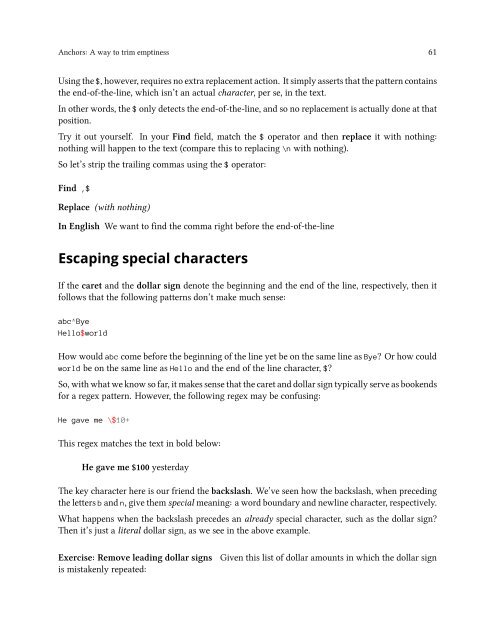Download - The Bastards Book of Regular Expressions
Download - The Bastards Book of Regular Expressions
Download - The Bastards Book of Regular Expressions
You also want an ePaper? Increase the reach of your titles
YUMPU automatically turns print PDFs into web optimized ePapers that Google loves.
Anchors: A way to trim emptiness 61Using the $, however, requires no extra replacement action. It simply asserts that the pattern containsthe end-<strong>of</strong>-the-line, which isn’t an actual character, per se, in the text.In other words, the $ only detects the end-<strong>of</strong>-the-line, and so no replacement is actually done at thatposition.Try it out yourself. In your Find field, match the $ operator and then replace it with nothing:nothing will happen to the text (compare this to replacing \n with nothing).So let’s strip the trailing commas using the $ operator:Find ,$Replace (with nothing)In English We want to find the comma right before the end-<strong>of</strong>-the-lineEscaping special charactersIf the caret and the dollar sign denote the beginning and the end <strong>of</strong> the line, respectively, then itfollows that the following patterns don’t make much sense:abc^ByeHello$worldHow would abc come before the beginning <strong>of</strong> the line yet be on the same line as Bye? Or how couldworld be on the same line as Hello and the end <strong>of</strong> the line character, $?So, with what we know so far, it makes sense that the caret and dollar sign typically serve as bookendsfor a regex pattern. However, the following regex may be confusing:He gave me \$10+This regex matches the text in bold below:He gave me $100 yesterday<strong>The</strong> key character here is our friend the backslash. We’ve seen how the backslash, when precedingthe letters b and n, give them special meaning: a word boundary and newline character, respectively.What happens when the backslash precedes an already special character, such as the dollar sign?<strong>The</strong>n it’s just a literal dollar sign, as we see in the above example.Exercise: Remove leading dollar signsis mistakenly repeated:Given this list <strong>of</strong> dollar amounts in which the dollar sign


